Roger B. Dannenberg
Everyone-Can-Sing: Zero-Shot Singing Voice Synthesis and Conversion with Speech Reference
Jan 23, 2025Abstract:We propose a unified framework for Singing Voice Synthesis (SVS) and Conversion (SVC), addressing the limitations of existing approaches in cross-domain SVS/SVC, poor output musicality, and scarcity of singing data. Our framework enables control over multiple aspects, including language content based on lyrics, performance attributes based on a musical score, singing style and vocal techniques based on a selector, and voice identity based on a speech sample. The proposed zero-shot learning paradigm consists of one SVS model and two SVC models, utilizing pre-trained content embeddings and a diffusion-based generator. The proposed framework is also trained on mixed datasets comprising both singing and speech audio, allowing singing voice cloning based on speech reference. Experiments show substantial improvements in timbre similarity and musicality over state-of-the-art baselines, providing insights into other low-data music tasks such as instrumental style transfer. Examples can be found at: everyone-can-sing.github.io.
Foundation Models for Music: A Survey
Aug 27, 2024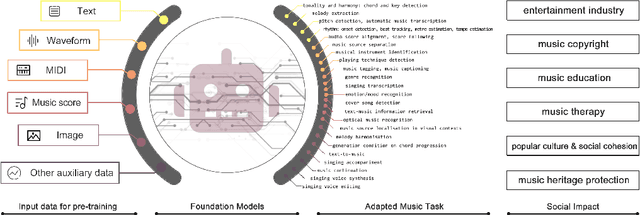
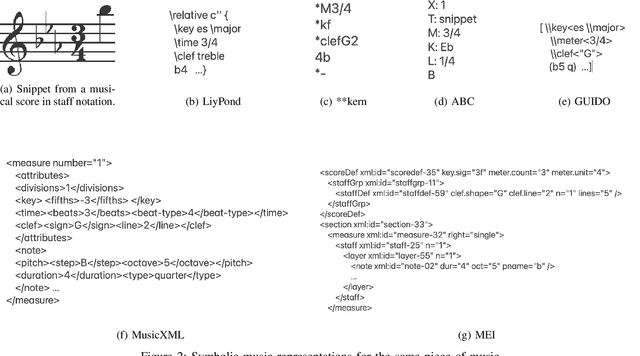
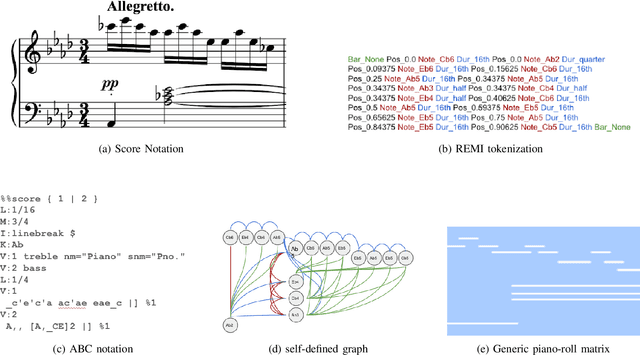
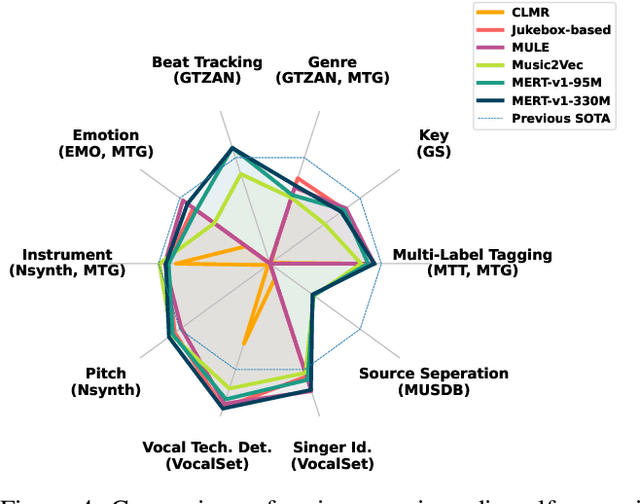
Abstract:In recent years, foundation models (FMs) such as large language models (LLMs) and latent diffusion models (LDMs) have profoundly impacted diverse sectors, including music. This comprehensive review examines state-of-the-art (SOTA) pre-trained models and foundation models in music, spanning from representation learning, generative learning and multimodal learning. We first contextualise the significance of music in various industries and trace the evolution of AI in music. By delineating the modalities targeted by foundation models, we discover many of the music representations are underexplored in FM development. Then, emphasis is placed on the lack of versatility of previous methods on diverse music applications, along with the potential of FMs in music understanding, generation and medical application. By comprehensively exploring the details of the model pre-training paradigm, architectural choices, tokenisation, finetuning methodologies and controllability, we emphasise the important topics that should have been well explored, like instruction tuning and in-context learning, scaling law and emergent ability, as well as long-sequence modelling etc. A dedicated section presents insights into music agents, accompanied by a thorough analysis of datasets and evaluations essential for pre-training and downstream tasks. Finally, by underscoring the vital importance of ethical considerations, we advocate that following research on FM for music should focus more on such issues as interpretability, transparency, human responsibility, and copyright issues. The paper offers insights into future challenges and trends on FMs for music, aiming to shape the trajectory of human-AI collaboration in the music realm.
Modeling Analog Dynamic Range Compressors using Deep Learning and State-space Models
Mar 24, 2024Abstract:We describe a novel approach for developing realistic digital models of dynamic range compressors for digital audio production by analyzing their analog prototypes. While realistic digital dynamic compressors are potentially useful for many applications, the design process is challenging because the compressors operate nonlinearly over long time scales. Our approach is based on the structured state space sequence model (S4), as implementing the state-space model (SSM) has proven to be efficient at learning long-range dependencies and is promising for modeling dynamic range compressors. We present in this paper a deep learning model with S4 layers to model the Teletronix LA-2A analog dynamic range compressor. The model is causal, executes efficiently in real time, and achieves roughly the same quality as previous deep-learning models but with fewer parameters.
Motif-Centric Representation Learning for Symbolic Music
Sep 19, 2023


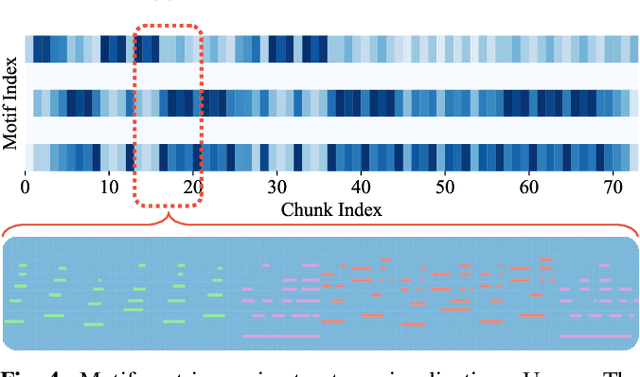
Abstract:Music motif, as a conceptual building block of composition, is crucial for music structure analysis and automatic composition. While human listeners can identify motifs easily, existing computational models fall short in representing motifs and their developments. The reason is that the nature of motifs is implicit, and the diversity of motif variations extends beyond simple repetitions and modulations. In this study, we aim to learn the implicit relationship between motifs and their variations via representation learning, using the Siamese network architecture and a pretraining and fine-tuning pipeline. A regularization-based method, VICReg, is adopted for pretraining, while contrastive learning is used for fine-tuning. Experimental results on a retrieval-based task show that these two methods complement each other, yielding an improvement of 12.6% in the area under the precision-recall curve. Lastly, we visualize the acquired motif representations, offering an intuitive comprehension of the overall structure of a music piece. As far as we know, this work marks a noteworthy step forward in computational modeling of music motifs. We believe that this work lays the foundations for future applications of motifs in automatic music composition and music information retrieval.
Controllable deep melody generation via hierarchical music structure representation
Sep 02, 2021



Abstract:Recent advances in deep learning have expanded possibilities to generate music, but generating a customizable full piece of music with consistent long-term structure remains a challenge. This paper introduces MusicFrameworks, a hierarchical music structure representation and a multi-step generative process to create a full-length melody guided by long-term repetitive structure, chord, melodic contour, and rhythm constraints. We first organize the full melody with section and phrase-level structure. To generate melody in each phrase, we generate rhythm and basic melody using two separate transformer-based networks, and then generate the melody conditioned on the basic melody, rhythm and chords in an auto-regressive manner. By factoring music generation into sub-problems, our approach allows simpler models and requires less data. To customize or add variety, one can alter chords, basic melody, and rhythm structure in the music frameworks, letting our networks generate the melody accordingly. Additionally, we introduce new features to encode musical positional information, rhythm patterns, and melodic contours based on musical domain knowledge. A listening test reveals that melodies generated by our method are rated as good as or better than human-composed music in the POP909 dataset about half the time.
Personalized Popular Music Generation Using Imitation and Structure
May 10, 2021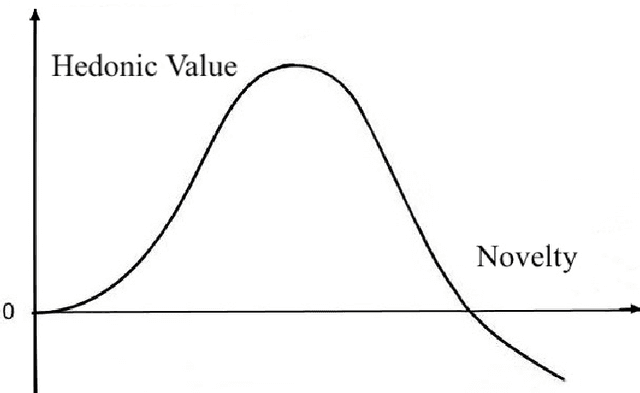

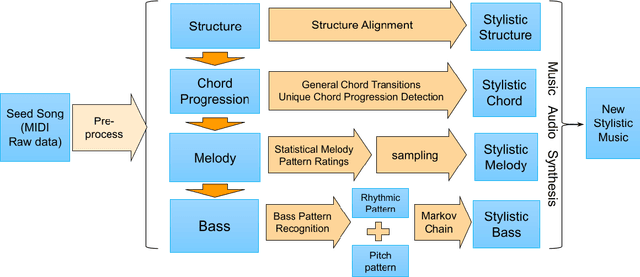

Abstract:Many practices have been presented in music generation recently. While stylistic music generation using deep learning techniques has became the main stream, these models still struggle to generate music with high musicality, different levels of music structure, and controllability. In addition, more application scenarios such as music therapy require imitating more specific musical styles from a few given music examples, rather than capturing the overall genre style of a large data corpus. To address requirements that challenge current deep learning methods, we propose a statistical machine learning model that is able to capture and imitate the structure, melody, chord, and bass style from a given example seed song. An evaluation using 10 pop songs shows that our new representations and methods are able to create high-quality stylistic music that is similar to a given input song. We also discuss potential uses of our approach in music evaluation and music therapy.
Be Careful What You Backpropagate: A Case For Linear Output Activations & Gradient Boosting
Jul 13, 2017



Abstract:In this work, we show that saturating output activation functions, such as the softmax, impede learning on a number of standard classification tasks. Moreover, we present results showing that the utility of softmax does not stem from the normalization, as some have speculated. In fact, the normalization makes things worse. Rather, the advantage is in the exponentiation of error gradients. This exponential gradient boosting is shown to speed up convergence and improve generalization. To this end, we demonstrate faster convergence and better performance on diverse classification tasks: image classification using CIFAR-10 and ImageNet, and semantic segmentation using PASCAL VOC 2012. In the latter case, using the state-of-the-art neural network architecture, the model converged 33% faster with our method (roughly two days of training less) than with the standard softmax activation, and with a slightly better performance to boot.
 Add to Chrome
Add to Chrome Add to Firefox
Add to Firefox Add to Edge
Add to Edge